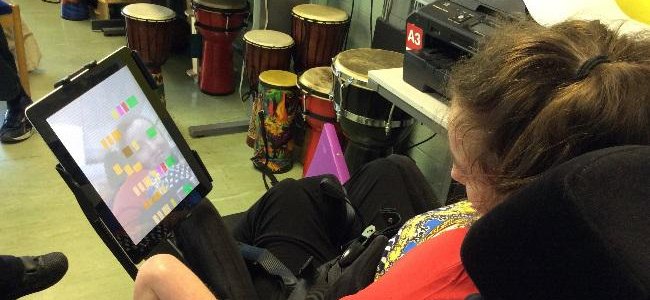So many young people may spend large periods of time with either the ever-intrusive ‘hand over hand’ support, or only making a verbal indication about what they want to see happen on screen. It can be incredibly liberating to finally have some independent control over an activity after so long of just watching, or making only a passive contribution to a task. The photograph above shows a young person controlling an iPad App with head movements. She is elated to be actually in control of the sounds.
Switch access can be beneficial with the right software, but there are limitations to what a switch or series of switches can do. With the advent of Kinect technology, so much more is available at a low cost. The generosity of the developers’ decision to leave it open source has allowed it to take on many forms and reach a wider audience. The potential to the SEN market is massive; when Wii first came out, the idea that a wheelchair user could experience activities they would struggle with in real life was fantastic.
With some learners still struggling to even hold the controller and co-ordinate the buttons, the hands-free technology of Kinect or Camera Mouse was revolutionary. Camera Mouse uses a webcam to track movement, and while it’s not nearly as sensitive as eye gaze hardware, the tradeoff of virtually no cost - just a simple webcam and a free download - is well worth it. UMoove is currently developing software with only face and eye tracking technology. This makes use of the built-in camera, and it is being marketed to the gaming industry as a Virtual Reality style game. The (free!) app UMoove Experience certainly has the wow factor, but there is little mention of the possibilities for SEN accessibility potential. A learner with limited arm movements can successfully play the game with just a mere turn of the head.
LeapMotion was marketed as a futuristic gadget, with again, no mention of its use for learners with SEN. However, it has proved successful as an access device for interacting with the on-screen games, with only simple hand movements and no grip required. Even Makey Makey, the crocodile-clip-connect-to-anything controller, has more than just novelty value for learners with SEN; imagine using your own knee as the switch to activate the space bar or whatever key you choose. It can be personalised to the movements of individual learners so that whatever body part has the most control, be it a foot or just a finger, the connection can be clipped into the most appropriate position.
The tablet market is embracing the power of the built-in camera as a controller; the possibilities for low-cost SEN access are virtually unlimited. A tablet can be a multi-tool for the SEN learner – a communication aid, a library with reading support, a maths tutor, a calendar, a social story library, a window on the world. Apple has supported SEN learners with a whole host of Accessibility Settings. The camera can be used as a switch, meaning just a tilt of the head can activate a function. Tilt right for one function, tilt left for another. It can be tricky to actually use; very frustrating when the head tilt activates the home button and the App closes unexpectedly. With practice and carefully selected settings, it could be personalised to suit the needs of individual learners.
The iPad can be a great resource for even the most profoundly challenged learner. At its most basic level it can provide auditory and / or visual stimulation, requiring no additional user input at all. One step up from that is random touch – just touching the screen anywhere activates a result. This can be set up in Accessibility Settings or may be built in to the App. Separating the iPad from the sound, using a Bluetooth speaker to bring the sound closer to the ears is an effective way of using it as a switch device for learners with limited arm movement.
There are a range of mounts available for tablets; they can be positioned in the most appropriate position for ease of use; for learners with very limited movements, the tablet could be placed near the head so that any visual results are easily seen. An additional switch, such as a Bluetooth one, could be placed under the learner’s hand so that minimal movement is required, just a switch press to activate the reward.
The iPad Accessibility Settings allow for scanning selection, which require patience and co-ordination to use. The Assistive Touch options enable the iPad to be personalised with different gestures that access chosen functions. Whilst Apple may not have the largest share of the tablet market, it is the only supplier that has focused on SEN accessibility in greater detail than just font size/colour. Apple describes iOS as ‘intuitive’ and in many aspects, it is. The aforementioned initiatives are all very exciting, but often require a PC or laptop as well as the gadgets themselves. An iPad is a simple to carry, all in one solution for fulfilling the criteria for Accessible Accessibility.
Are you an SEN teacher? What technology do you utilise in the classroom


















